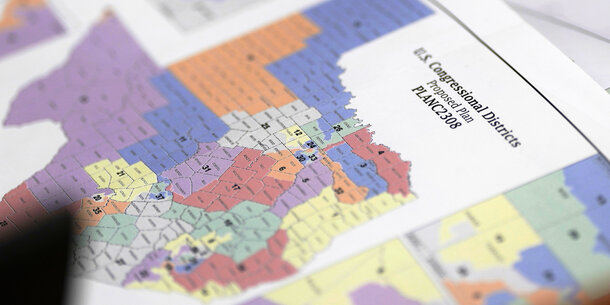In the coming months, the Supreme Court will decide whether a Louisiana congressional district created to conform with the Voting Rights Act resulted in an unconstitutional gerrymander that discriminates based on race. The result could further weaken the landmark civil rights law and fair representation for the nation’s growing communities of color.
The story of the case, argued in late March, is a winding one that began in 2021 when lawmakers redrew the state’s six congressional districts after the 2020 census.
Although the census showed that Black Louisianans were now nearly a third of the state’s population, lawmakers chose to make only minor tweaks to the existing congressional map. That map, in both its original and revised forms, was unsatisfactory from the standpoint of Black voters because it divided their communities in a way that allowed the state’s sizable Black population to elect its preferred candidates in just one of six congressional districts.
In each of the remaining five districts, Black voters were divided in ways that made them too small of a share of the population to overcome Louisiana’s highly racially polarized voting patterns. White voters, who now vote overwhelmingly Republican in most of Louisiana, determined who won or lost in every election.
Black voters sued in federal court, contending that the division of Black communities in the congressional map violated Section 2 of the Voting Rights Act, which allows minority voters to challenge maps that have a racially discriminatory effect. They argued that if lawmakers had reconfigured district boundaries just slightly, it would have been possible to easily create a second Black-majority district. In fact, they argued it would be possible to create such a district while better complying with Louisiana race-neutral map-drawing rules than the state’s own map.
The plaintiffs won an injunction blocking the state’s map. That ruling was put on hold for the 2022 election cycle but was ultimately affirmed in late 2023 by a unanimous panel of the Fifth Circuit Court of Appeals.
By that point, the 2024 election was fast approaching, putting Louisiana lawmakers in a conundrum. Carrying on with litigation would significantly increase the chance that a federal court would redraw the state’s map into one that lawmakers and other politically important stakeholders found unacceptable.
To avoid that outcome, lawmakers gave up the court fight and instead met in a special session in early 2024 to adopt a new map. During the remedial legislative session, the Black voters who brought the case proposed a map with a compact second Black majority district on the eastern side of the state along the Mississippi Delta, similar to the one they had offered during their Voting Rights Act litigation. Their proposal deliberately made minimal changes to the state’s 2021 map.
However, Republican lawmakers rejected the proposal because of its political effects, in particular the fact that the map would have made the district favored Republican congressional incumbent Rep. Julia Letlow much more heavily Democratic. They also disliked the map because it would have made the adjacent districts of other powerful Republicans, including House Speaker Mike Johnson and Majority Leader Steve Scalise, too competitive for comfort.
Instead, lawmakers decided to draw a Black-majority district that sprawled from Shreveport, in the northwest corner of the state next the Texas border, to Baton Rouge, more than 200 miles southeast — using the redrawing process not only to protect Letlow and other favored Republican incumbents but to dismantle the solidly red congressional district of Republican Rep. Garrett Graves, who had often found himself at odds with Republican governor Jeff Landry.
Although the new district is very different from the more compact district Black plaintiffs proposed in the Voting Rights Act litigation, the state argued it nonetheless satisfied its obligations under the law because it could demonstrate that Black voters had the ability to elect candidates in both districts and because the state’s version of the district shared about 70 percent of the same population as the one Black voters proposed.
Though state officials were happy enough with the new map, some white voters were not.
Shortly after adoption of the new map, they filed suit in a different federal district court, claiming that the new voting district was an illegal racial gerrymander because race had unconstitutionally predominated in lawmakers’ decisions about how to draw lines. (Black plaintiffs in the original Voting Rights Act suit intervened in the new lawsuit.)
Racial gerrymandering claims challenging maps for an overuse of race have been around since the 1990s and have been used over the years by both white and minority voters to challenge maps. The evidence in these cases can often be head-spinningly complicated, especially when the courts are required to examine information about raw partisanship and its intersection with race and the Voting Rights Act.
Here, however, Louisiana lawmakers and the Black plaintiffs in the original Voting Rights Act lawsuit offered very straightforward defenses.
After all, both a district court and the conservative Fifth Circuit had agreed that the Voting Rights Act required creating a second Black congressional district. Moreover, Black plaintiffs had proven in the original case that it was possible for lawmakers to easily satisfy that obligation by drawing a compact Black-majority district in the northeastern part of the state.
The fact that lawmakers opted instead to draw a far less compact Baton Rouge-to-Shreveport district was seemingly strong evidence that some factor besides race — namely politics — was the predominant driver for map drawers’ choices. And while partisan map drawing might be distasteful, well, the Supreme Court said in 2019 and again last year that configuring districts for political advantage is a perfectly permissible end.
Nonetheless, a three-judge panel ruled in favor of the white plaintiffs in a 2–1 decision, striking down the map. The Supreme Court issued a stay of the decision during appeals to the Supreme Court, allowing Black Democrat Cleo Fields to win office in 2024 under the redrawn map.
The issue now before the Court will determine whether that map remains in place for 2026 and subsequent elections. If the decision striking down the map is upheld by the Supreme Court, the outcome could weaken the Voting Rights Act both by creating a presumption of racial gerrymandering whenever map drawers create a majority-minority district or, alternatively, by sharply limiting how far states can go when addressing even court-ordered remediation of Voting Rights Act violations.
But there is reason to hope that the Supreme Court won’t do so.
Much of the March oral argument focused on whether the district court’s injunction, affirmed by the Fifth Circuit, was sufficient to give Louisiana a “reasonable basis” for drawing the second Black congressional district. While some of the conservative justices seemed willing to probe the underlying court findings of Voting Rights Act liability, most justices seemed satisfied that following a court order affirmed by the Fifth Circuit was more than sufficient reason to draw the second district.
More uncertain is whether the Court might conclude that the state went too far when it addressed Voting Rights Act violations by creating the Baton Rouge-to-Shreveport district. If it does, it could order yet another redraw of Louisiana’s congressional map — perhaps resulting in a district more like the one originally proposed by Black plaintiffs.
But even if the map survives, Justice Brett Kavanaugh asked questions that could signal trouble in the not-too-distant future.
The current framework for deciding Section 2 cases has its origins in a landmark 1986 Supreme Court case. Under the structure created by that case, if a map has a racially discriminatory effect — as determined in a fact-intensive, locality specific inquiry — a court can order that it be redrawn. When states do so, courts permit them to take race into consideration, though a separate line of court cases says that race cannot be the sole or predominate reason for line-drawing choices.
But Kavanaugh wondered whether that framework might be outdated, pointedly asking each of the arguing attorneys whether the race-conscious line-drawing permitted under the 1986 case should have an expiration date.
The Court is unlikely to reach that issue in this case because the white plaintiffs only raised the it for the first time on appeal. But the questions are an ominous sign that a showdown over the continued viability of the nearly 40-year-old judicially created framework for Section 2 cases may not be far off.
That fight could in fact come as soon as the next Supreme Court term in a pair of cases from Georgia challenging congressional and legislative maps or from a Louisiana case challenging legislative maps. Those cases are currently on appeal in the 11th and 5th Circuits and could reach the Supreme Court as early as fall.



